
May 20, 2020, 7:00 AM By Sarah Royce-Greensill
Why the super-rich are investing in diamonds and rare gemstones in lockdown
Amid economic uncertainty, the super-rich are looking to ultra-rare precious gemstones as a ‘safe’ store for their wealth
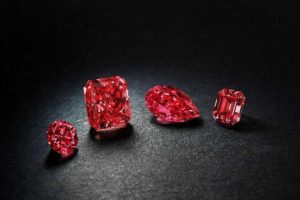
Jewellers have seen steady demand for high-end gemstones even amid the Covid-19 crisis
Fine jewellery sales are seeming to weather the coronavirus crisis, thanks to lockdown proposals and demand for precious pieces to mark birthdays and anniversaries. Some jewellers report that people are spending more on gifts than usual, in lieu of ‘proper’ face-to-face celebrations.
And at the high end of the market, collectors are still investing in rare gemstones – sometimes seeing them as a safer store for their money than the volatile stock market or property.
Krishna Choudhary, the founder of Santi Jewels, sold two highly important and historical (read: expensive) gemstones, a Golconda diamond and a Colombian emerald, just after lockdown began.
“Personally, I didn’t think it was the right time to be selling, but I reached out to my existing clients to send my best wishes and those who had been thinking about a certain piece decided now was the time to bring some cheer into their life and acquire it,” he says.

Carved emerald and diamond ring by Santi Jewels
“They see these historical stones as investments. With their character, age, colour and quality they are impossible to replace. To come across another one similar would be a dream, even for me.
“Uncertainty in the stock market definitely played a role in their buying decision, but also they’d had time to think and decide that they wanted to make this investment.”
Charlie Pragnell, managing director of family-run jeweller Pragnell, has also seen steady demand for high-end pieces. “Rare items such as Patek Philippe and Rolex watches, individual antique jewellery or rare gemstones continue to be desirable,” he says.
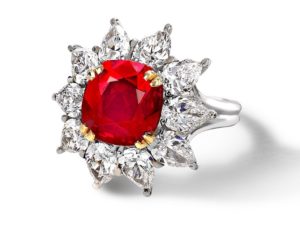
Burmese ruby and diamond ring by Pragnell
“Often people look for months or years for a certain gemstone: it’s a long-term desire and this crisis doesn’t change that. High quality and rarity retains value, in all markets. We have a customer who has been searching for a Burmese ruby to celebrate their upcoming ruby wedding anniversary: that anniversary is still going to happen.”
With time on their hands, high-net-worth clients have ample opportunity to consider significant purchases.
“When Harrods and our boutique closed at the end of March, our staff messaged clients just to send their best wishes. A couple of weeks later I think people were bored and they started messaging back asking whether we are still able to sell,” says Sameer Lilani, Amrapali’s EMEA director.
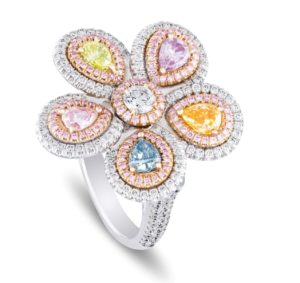
A Fancy coloured diamond ring by Amrapali
“Most sales in this period have been at entry-level price points – between £1,000 and £10,000 – but we have also had clients enquiring about really special stones, like a vivid blue diamond for tens of millions. We’ve been discussing that transaction since early January but this crisis hasn’t deterred the buyer.
“In the higher tier of the market, people’s jobs are secure, they’re not going away on holiday or spending much elsewhere, so a lot of diamond dealers I know are pretty optimistic,” he continues.
These high-net-worth clients see rare gemstones as a wise investment, “one hundred percent,” says Lilani. “I know dealers in Hong Kong who have closed two big deals above $10 million in the last couple of weeks, and another friend has just sold an ultra-rare pigeon’s blood ruby, and a 20-carat Kashmir sapphire that went for $200,000 per carat.”

A Fancy blue radiant-cut diamond ring by Amrapali
Like in the property market, the fact that some people need to sell presents opportunities for buyers, for certain stones.
“People are being flexible in the price they are asking, particularly for white and yellow diamonds,” says Lilani. “I was recently contacted about a 50-carat intense yellow diamond that the seller was offering for 20 per cent less per carat than in February.”
But at the very highest end of the market, for top-quality Kashmir sapphires and ultra-rare vivid blue and pink diamonds, Lilani says “I don’t see there being much of a downward shift because everybody recognises how rare those stones are.”
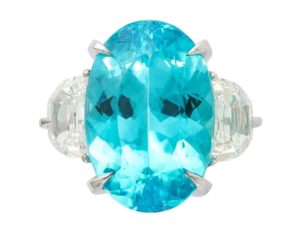
Paraiba tourmaline and diamond ring by Ara Vartanian
In some cases, demand is outstripping supply, which is limited due to global travel restrictions. “I’ve been seeing demand from people who are seeking out rare gems, but they’re becoming even more difficult to get hold of,” says Ara Vartanian, who specialises in rare Brazilian gemstones including electric blue-green Paraiba tourmalines. A top-quality 18-carat Paraiba has been garnering a lot of interest since lockdown began, he says.
“The mines are closed so there are no new stones coming onto the market. A lot of the gemstone dealers are closed. Transportation of merchandise is nearly impossible. These gemstones usually travel more than people: from India to Hong Kong, Antwerp, Brazil, New York…now it’s a complete mess.”
Vartanian’s clients want to see stones in person before they buy, but that is proving difficult.

Paraiba tourmaline and diamond earrings by Ara Vartanian
“I now have a situation where I have clients who have the funds and are looking to buy a special rare gem, because he or she would rather have that tangible, valuable asset that they can carry with them, but either the supply isn’t there or the gems I do have, there’s no way for them to see it,” he says. “The good materials are harder and harder to find and the prices will start to reflect that.”
In Asia, strong jewellery sales at the high end are one sign that consumers are ready and willing to spend again. “One of our VIP clients, a big art and jewellery collector, wanted some advice on her jewellery investment, so I arranged a Zoom call to meet her virtually,” says Taiwanese jeweller Cindy Chao, who makes just a handful of pieces every year under her label Cindy Chao The Art Jewel.
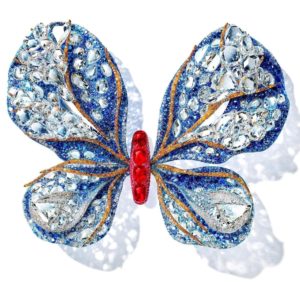
Cindy Chao The Art Jewel 2019 Aurora Butterfly
“A lot of clients have started to come back to our private showrooms in Hong Kong. They are all safe, but it seems the virus has taken its toll on them psychologically. One client told us that post-quarantine, the only thing she wanted to do was see beautiful pieces.”
After seeing demand from Chinese collectors continue to increase, Chao still plans to open a private showroom in Shanghai later this year.
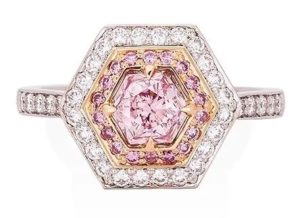
Pink hexagonal diamond ring by Boodles
All jewellers agree that close client relationships are essential for businesses to thrive in times like these. When face-to-face interaction isn’t possible, trust is even more important.
“Much of our business is done on the basis of genuine customer relationships; these will still be in place after this crisis, and we’ve received many messages from people saying how much they’re looking forward to meeting us again,” says James Amos, director at Boodles. “There are glimmers of light at the end of the tunnel.”
Amos continues, “Boodles is 220 years old and has survived very difficult times. More broadly speaking, history indicates that jewellery has retained its popularity throughout the ages, for thousands of years. At this time when people can’t spend the substantial amount they’d usually spend on a holiday, perhaps they’ll buy a nice piece of jewellery instead.”
